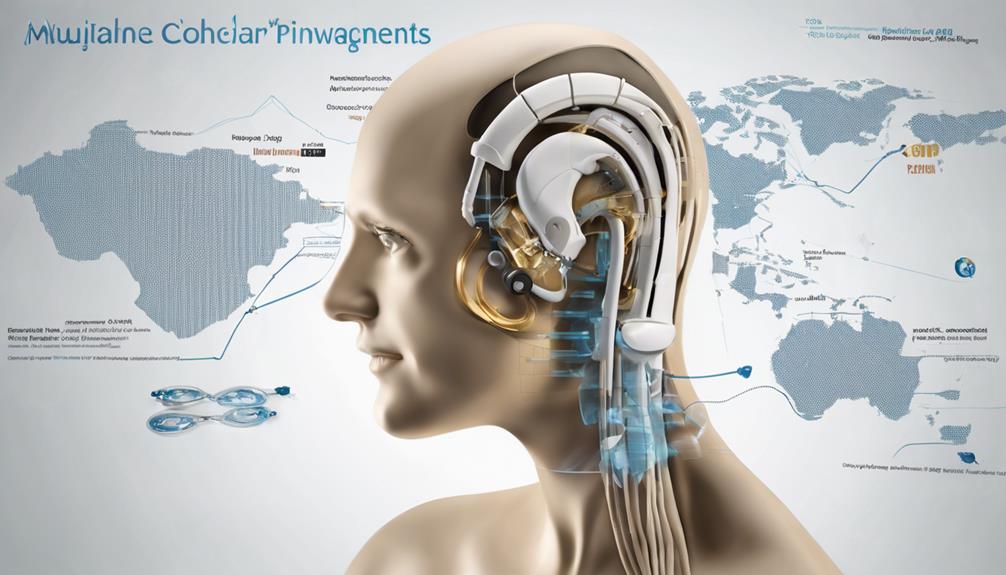Think of it as being a maze runner, navigating through the twists and turns of financial decisions, delving into the intricate realm of insurance specifics, and unraveling the complicated puzzle of costs associated with obtaining a cochlear implant.
As we unveil pragmatic insights into cost-effective strategies, we shed light on innovative approaches that could revolutionize accessibility to this life-changing technology.
By dissecting each facet with precision, we aim to equip you with the tools to navigate the financial landscape of cochlear implants with confidence and clarity.
Key Takeaways
- Understand insurance coverage for cochlear implants to make informed decisions.
- Analyze long-term expenses for maintenance and technology upgrades.
- Explore warranty benefits and insurance options for upgrade coverage.
- Benefit from personal experiences showcasing improved quality of life post-implantation.
Insurance Coverage and Financial Assistance
Insurance plans widely cover cochlear implants and bone conduction solutions, ensuring financial assistance for recipients of these hearing devices. Medicare, Medicaid, and many private insurance plans recognize the importance of hearing health and offer coverage for cochlear implants, alleviating the financial burden on individuals seeking these interventions. While traditional hearing aids may not receive the same level of coverage, some Medicare Advantage Plans extend benefits to include them, providing additional support for beneficiaries.
For those considering cochlear implants, the availability of insurance coverage can significantly impact decision-making processes. Understanding the specifics of coverage under Medicare, Medicaid, or private insurance is crucial in planning for the financial aspects of the procedure. By exploring the options available through different insurance plans, beneficiaries can make informed choices regarding their hearing implant journey. It's essential to consult with insurance providers to ascertain the extent of coverage and any out-of-pocket expenses that may arise.
Cost Breakdown and Long-Term Expenses

When considering the financial implications of cochlear implant usage, it's essential to meticulously analyze the breakdown of long-term expenses. Understanding the cost breakdown and long-term expenses associated with cochlear implants is crucial for effective financial planning. Here are key components to consider:
- Maintenance Costs: Regular maintenance expenses for sound processors, batteries, and accessories are part of the long-term costs of cochlear implants.
- Replacement Parts: Long-term expenses include the need for replacement parts such as cables, coils, and magnets to ensure the proper functioning of the cochlear implant.
- Technology Upgrades: Over the lifetime of the cochlear implant, technology upgrades may become available to enhance performance, but they could also result in additional costs.
Warranty and Upgrades Information
Exploring the warranty coverage and upgrade options for cochlear implants reveals essential information for long-term maintenance and performance enhancement. Warranty coverage typically includes replaceable parts such as cables, coils, magnets, and batteries, ensuring the longevity of the device. Moreover, advancements in cochlear technology allow for seamless technology upgrades without the necessity of additional surgery, enhancing the user experience.
When considering upgrades, it's crucial to note that many health insurance plans partially cover the costs associated with these enhancements. Investigating insurance eligibility for upgrade coverage is recommended, and individuals may also explore self-paying options for upgrades not fully covered by insurance. For those seeking financial assistance with warranty inquiries or upgrades, reaching out to Cochlear directly can provide valuable support and guidance in navigating the available options.
Personal Cochlear Implant Experiences

Understanding the diverse impact of cochlear implants on individuals' hearing needs and preferences is crucial in exploring personal cochlear implant experiences. Personal accounts often highlight significant improvements in speech perception, leading to enhanced quality of life.
Access to sound and communication is greatly improved post-implantation, providing individuals with a newfound ability to engage more fully in the world around them. Cochlear implant recipients frequently undergo auditory therapy to optimize their hearing potential and aid in adjusting to new sounds.
These experiences underscore the importance of considering individual preferences and unique requirements when embarking on the cochlear implant journey. Hearing success stories from those who've undergone the procedure serve as valuable sources of insight and encouragement for individuals contemplating cochlear implantation.
Cost-Effectiveness Analysis in Cochlear Implants
Cost-effectiveness analysis in cochlear implants evaluates the economic value of implantation procedures and their associated outcomes by comparing costs and benefits. This analytical approach considers factors such as quality-adjusted life years (QALYs) gained, incremental cost-effectiveness ratios (ICER), and the long-term cost implications of cochlear implant interventions.
Decision-makers rely on cost-effectiveness thresholds to assess the viability of investing in cochlear implant programs. These analyses play a crucial role in guiding healthcare resource allocation by demonstrating the value of cochlear implants in enhancing patient outcomes and improving quality of life.
Frequently Asked Questions
What Is the Cost Effectiveness of Cochlear Implantation in Single Sided Deafness?
Cochlear implantation in single sided deafness showcases cost-effectiveness, enhancing quality of life and speech perception. Studies reveal that unilateral cochlear implants in these cases are cost-effective at specific thresholds. Factors like quality-adjusted life years gained and incremental cost-effectiveness ratios influence the overall cost-effectiveness.
Markov models aid in evaluating the economic benefits of cochlear implants in single sided deafness, offering valuable insights. Cost-effectiveness analyses underscore the advantages of cochlear implantation in improving outcomes and economic benefits.
What Is the Strategic Plan of Cochlear?
We focus on providing cost-effective solutions for cochlear implants. Our strategic plan enhances accessibility through collaborations with healthcare providers.
We optimize resources to reduce overall costs and continually innovate to improve technology cost-effectiveness.
This approach ensures efficient and affordable cochlear implant programs.
Conclusion
In the symphony of life, the cost-effective strategies for cochlear implants serve as the harmonious notes that bridge the gap between accessibility and affordability.
Just as a conductor orchestrates a flawless performance, understanding insurance coverage, seeking financial assistance, and exploring upgrade options conduct a seamless melody of financial navigation for individuals with hearing loss.
Let's continue to fine-tune our approach to cost analyses and make the world of cochlear implants a more harmonious place for all.











